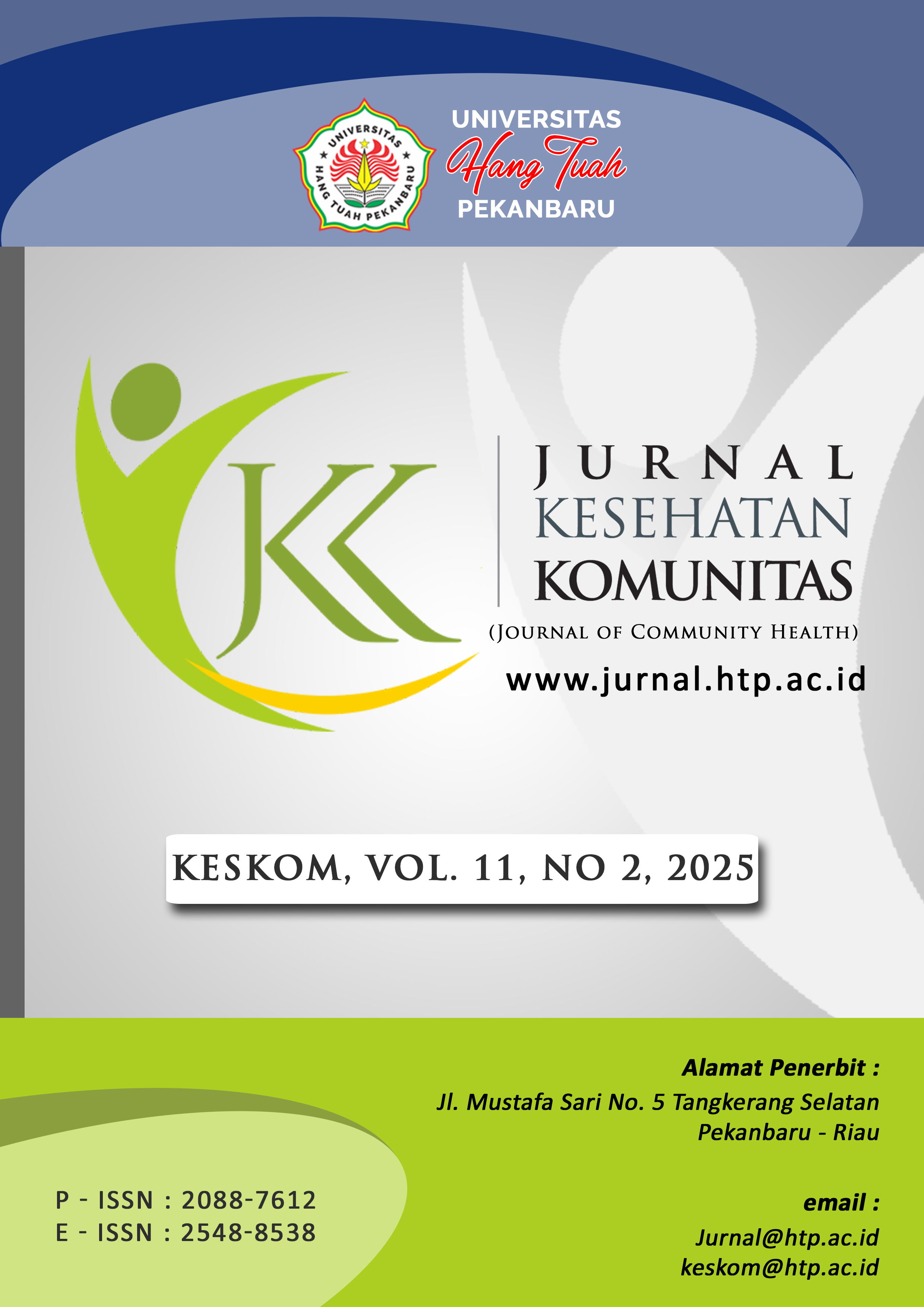Determinan Perawatan Bayi Berat Lahir Rendah di Wilayah Pertanian dan Pesisir Berperspektif Keluarga
DOI:
https://doi.org/10.25311/keskom.Vol11.Iss2.2211Kata Kunci:
Berat Badan Lahir Rendah, perawatan, pertanian, pesisirAbstrak
Bayi berat lahir rendah (BBLR) di daerah pertanian dan pesisir memiliki masalah kesehatan yang berbeda sehingga mungkin memiliki kebutuhan perawatan yang berbeda. Promosi kesehatan anak khususnya BBLR baik di tatanan pelayanan klinik ataupun komunitas yang tidak sesuai dapat meningkatkan angka kesakitan dan kematian. Tujuan penelitian ini adalah untuk mengidentifikasi faktor penentu pemenuhan kebutuhan perawatan BBLR berdasarkan perspektif keluarga di daerah pesisir dan pertanian. Penelitian observasional ini dilakukan dengan menggunakan kuesioner pada anak dan ibu di daerah pesisir dan pertanian. Multistage random cluster sampling dengan aplikasi G*Power mendapatkan193 partisipan yang dipilih dari setiap daerah, sehingga total sampel sebanyak 386. Analisis data dilakukan dengan menggunakan uji beda rerata dua wilayah. Hasil studi menunjukkan wilayah pertanian memiliki rerata lebih tinggi pada nilai perawatan BBLR, stres orang tua, dan pemberdayaan keluarga. Sedangkan wilayah pesisir memiliki rerata tinggi pada nilai kualitas hidup, kesiapan ibu merawat bayi, dan praktik keberagaman pangan. Terdapat perbedaan yang signifikan antara pesisir dan pertanian pada determinan pemenuhan kebutuhan BBLR terutama pada variabel kualitas hidup orang tua (p=0,000), stres orang tua (p=0,029), kesiapan ibu (p-0,000) dan pemberdayaan keluarga (p= 0,000). Optimalisasi promosi kesehatan oleh perawat anak dalam lingkup pelayanan rumah sakit maupun komunitas dapat dilakukan dengan memberdayakan keluarga dan memperhatikan faktor stres pengasuhan, kesiapan merawat, kepercayaan diri, dan kualitas hidup orang tua.
Unduhan
Referensi
[1] Kemenkes RI, Profil Kesehatan Indonesia 2020, vol. 48, no. 1. Jakarta: Kementerian Kesehatan RI.2021, 2021. doi: 10.1524/itit.2006.48.1.6. DOI: https://doi.org/10.1524/itit.2006.48.1.6
[2] Y. Tomoyasu and I. Sobue, “Problems with Home Care of Low-birth-weight Infants: ‘Use of Little Baby Handbook’ to Support Low-birth-weight Infants and Families (Mothers),” J. Compr. Nurs. Res. Care, vol. 4, no. 1, pp. 1–5, 2019, doi: 10.33790/jcnrc1100135. DOI: https://doi.org/10.33790/jcnrc1100135
[3] C. S. Vilanova, V. N. Hirakata, V. C. De Souza Buriol, M. Nunes, M. Z. Goldani, and C. H. Da Silva, “The relationship between the different low birth weight strata of newborns with infant mortality and the influence of the main health determinants in the extreme south of brazil,” Popul. Health Metr., vol. 17, no. 1, pp. 1–12, 2019, doi: 10.1186/s12963-019-0195-7. DOI: https://doi.org/10.1186/s12963-019-0195-7
[4] F. A. Ogbo et al., “Determinants of trends in neonatal , post- neonatal , infant , child and under-five mortalities in Tanzania from 2004 to 2016,” pp. 1–12, 2019. DOI: https://doi.org/10.1186/s12889-019-7547-x
[5] J. Bater et al., “Predictors of low birth weight and preterm birth in rural Uganda: Findings from a birth cohort study,” PLoS One, vol. 15, no. 7 July, pp. 1–16, 2020, doi: 10.1371/journal.pone.0235626. DOI: https://doi.org/10.1371/journal.pone.0235626
[6] O. J. Sumampouw, J. E. Nelwan, and A. A. Rumayar, “Socioeconomic factors associated with diarrhea among under-five children in Manado Coastal Area, Indonesia,” J. Glob. Infect. Dis., vol. 11, no. 4, pp. 140–146, 2019, doi: 10.4103/jgid.jgid-105-18. DOI: https://doi.org/10.4103/jgid.jgid_105_18
[7] E. C. Keats et al., “Accelerating Kenya’s progress to 2030: Understanding the determinants of under-five mortality from 1990 to 2015,” BMJ Glob. Heal., vol. 3, no. 3, pp. 1–15, 2018, doi: 10.1136/bmjgh-2017-000655. DOI: https://doi.org/10.1136/bmjgh-2017-000655
[8] B. Lv et al., “Family-centered care improves clinical outcomes of very-low-birth-weight infants: A quasi-experimental study,” Front. Pediatr., vol. 7, no. APR, pp. 1–6, 2019, doi: 10.3389/fped.2019.00138. DOI: https://doi.org/10.3389/fped.2019.00138
[9] A. Iva Murty, “Saving Low Birth Weight Babies with Kangaroo Mother Care: Family Resilience and Social Capital as Success Factors,” J. Mod. Educ. Rev., vol. 8, no. 9, pp. 667–672, 2018, doi: 10.15341/jmer(2155-7993)/09.08.2018/004.
[10] E. S. Astuti, N. Nursalam, S. R. Devy, and R. Etika, “Knowledge , Family Support and Self-Reliance Capital when Caring for Low Birth Weight Babies,” vol. 14, no. 1, pp. 10–15, 2019. DOI: https://doi.org/10.20473/jn.v14i1.12734
[11] M. Gregory, L. Kannis-Dymand, and R. Sharman, “A review of attachment-based parenting interventions: Recent advances and future considerations,” Aust. J. Psychol., vol. 72, no. 2, pp. 109–122, 2020, doi: 10.1111/ajpy.12270. DOI: https://doi.org/10.1111/ajpy.12270
[12] T. Nordheim, T. Rustøen, A. L. Solevåg, M. C. Småstuen, and B. Nakstad, “Hope in Parents of Very-Low Birth Weight Infants and its Association with Parenting Stress and Quality of Life,” J. Pediatr. Nurs., vol. 38, pp. e53–e58, 2018, doi: 10.1016/j.pedn.2017.10.006. DOI: https://doi.org/10.1016/j.pedn.2017.10.006
[13] K. North et al., “Family Involvement in the Routine Care of Hospitalized Preterm or Low Birth Weight Infants: A Systematic Review and Meta-analysis,” Pediatrics, vol. 150, no. August, pp. 1–8, 2022, doi: 10.1542/peds.2022-057092O. DOI: https://doi.org/10.1542/peds.2022-057092O
[14] C. Schuler, G. E. Ntow, and F. Agbozo, “Mothers’ Experiences with Neonatal Care for Low Birth Weight Infants at Home; A Qualitative Study in the Hohoe Municipality, Ghana,” J. Pediatr. Nurs., vol. 45, no. xxxx, pp. e44–e52, 2019, doi: 10.1016/j.pedn.2018.12.017. DOI: https://doi.org/10.1016/j.pedn.2018.12.017
[15] J. Chen et al., “The association between work related factors and breastfeeding practices among Chinese working mothers : a mixed-method approach,” pp. 1–13, 2019. DOI: https://doi.org/10.1186/s13006-019-0223-z
[16] S. A. M. Lima et al., “Is the risk of low birth weight or preterm labor greater when maternal stress is experienced during pregnancy? A systematic review and meta-analysis of cohort studies,” PLoS One, vol. 13, no. 7, pp. 1–15, 2018, doi: 10.1371/journal.pone.0200594. DOI: https://doi.org/10.1371/journal.pone.0200594
[17] E. Umberger, J. Canvasser, and S. L. Hall, “Enhancing NICU parent engagement and empowerment,” Semin. Pediatr. Surg., vol. 27, no. 1, pp. 19–24, 2018, doi: 10.1053/j.sempedsurg.2017.11.004. DOI: https://doi.org/10.1053/j.sempedsurg.2017.11.004
[18] A. Ferrand, A. Gorgos, N. Ali, and A. Payot, “Resilience Rather than Medical Factors: How Parents Predict Quality of Life of Their Sick Newborn,” J. Pediatr., vol. 200, pp. 64-70.e5, 2018, doi: 10.1016/j.jpeds.2018.05.025. DOI: https://doi.org/10.1016/j.jpeds.2018.05.025
[19] R. M. Lubis, “Mother’s Behavior In Caring For Low Birth Weight Babies (LBW) At Home,” J. Midwifery Nurs., vol. 3, no. 3, pp. 93–97, 2021, doi: 10.35335/jmn.v3i3.1702. DOI: https://doi.org/10.35335/jmn.v3i3.1702
[20] L. Resmiya and I. H. Misbach, “PENGEMBANGAN ALAT UKUR KUALITAS HIDUP,” vol. 3, no. 1, pp. 20–31, 2019. DOI: https://doi.org/10.17509/insight.v3i1.22247
[21] R. Nur Aini, T. Susanto, and H. Rasni, “Parenting Stress and Physical Abuse against Children with Disabilities,” Inklusi, vol. 7, no. 1, p. 151, 2020, doi: 10.14421/ijds.070107. DOI: https://doi.org/10.14421/ijds.070107
[22] K. Russell, “Maternal Confidence of First-time Mothers during their Child ’ s Infancy,” 2006.
[23] H. H. Huang, T. Y. Lee, X. T. Lin, and H. Y. Duan, “Maternal Confidence and Parenting Stress of First-Time Mothers in Taiwan: The Impact of Sources and Types of Social Support,” Healthc., vol. 10, no. 5, 2022, doi: 10.3390/healthcare10050878. DOI: https://doi.org/10.3390/healthcare10050878
[24] F. Koren, De Chillo, “Research and Training Center on Family Support and Children’s Mental Health,” Reg. Res. Inst., 1992.
[25] WHO, “Indicators for assessing infant and young child feeding practices,” 2021.
[26] G. Martínez-Rico, C. Simón, M. Cañadas, and R. McWilliam, “Support Networks and Family Empowerment in Early Intervention,” Int. J. Environ. Res. Public Health, vol. 19, no. 4, 2022, doi: 10.3390/ijerph19042001. DOI: https://doi.org/10.3390/ijerph19042001
[27] V. Harries and A. Brown, “The association between use of infant parenting books that promote strict routines, and maternal depression, self-efficacy, and parenting confidence,” Early Child Dev. Care, vol. 189, no. 8, pp. 1339–1350, 2019, doi: 10.1080/03004430.2017.1378650. DOI: https://doi.org/10.1080/03004430.2017.1378650
[28] L. Takács, F. Smolík, and S. Putnam, “Assessing longitudinal pathways between maternal depressive symptoms, parenting self-esteem and infant temperament,” PLoS One, vol. 14, no. 8, pp. 1–18, 2019, doi: 10.1371/journal.pone.0220633. DOI: https://doi.org/10.1371/journal.pone.0220633
[29] C. Caporali et al., “A global perspective on parental stress in the neonatal intensive care unit: a meta-analytic study,” J. Perinatol., vol. 40, no. 12, pp. 1739–1752, 2020, doi: 10.1038/s41372-020-00798-6. DOI: https://doi.org/10.1038/s41372-020-00798-6
[30] E. S. Tambunan, H. Pratomo, E. N. Hadi, and Y. Rustina, “Knowledge of low birth weight care as a source of coping strategies for mothers: Cross sectional study in perinatology WARD’S,” J. Neonatal Nurs., 2020, doi: https://doi.org/10.1016/j.jnn.2020.01.003. DOI: https://doi.org/10.1016/j.jnn.2020.01.003
[31] M. Amorim, E. Alves, M. Kelly-irving, A. I. Ribeiro, and S. Silva, “Quality of life of parents of very preterm infants 4 months after birth : a mixed methods study,” pp. 1–12, 2018. DOI: https://doi.org/10.1186/s12955-018-1011-y
[32] M. Amorim, S. Silva, M. Kelly-Irving, and E. Alves, “Quality of life among parents of preterm infants: a scoping review,” Qual. Life Res., vol. 27, no. 5, pp. 1119–1131, 2018, doi: 10.1007/s11136-017-1771-6. DOI: https://doi.org/10.1007/s11136-017-1771-6
[33] Y. Baek and S. Chitekwe, “Sociodemographic factors associated with inadequate food group consumption and dietary diversity among infants and young children in Nepal,” PLoS One, vol. 14, no. 3, pp. 1–17, 2019, doi: 10.1371/journal.pone.0213610. DOI: https://doi.org/10.1371/journal.pone.0213610
Unduhan
Telah diserahkan
diterima
Diterbitkan
Cara Mengutip
Terbitan
Bagian
Lisensi
Hak Cipta (c) 2025 Jurnal Kesehatan Komunitas

Artikel ini berlisensiCreative Commons Attribution-NonCommercial-ShareAlike 4.0 International License.
Copyright @2017. This is an open-access article distributed under the terms of the Creative Commons Attribution-NonCommercial-ShareAlike 4.0 International License (http://creativecommons.org/licenses/by-nc-sa/4.0/) which permits unrestricted non-commercial used, distribution and reproduction in any medium












































